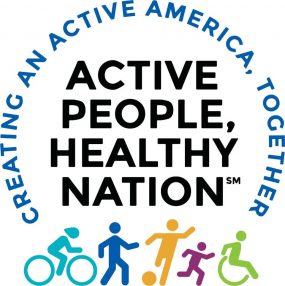Prompts to Encourage Physical Activity
Prompts to Encourage Physical Activity
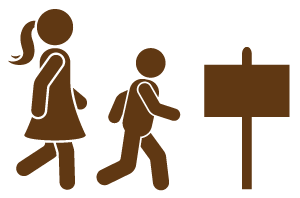
Prompts such as signs or reminders inform and motivate people to make an active choice in specific environments. Communities and institutions can use the following approach to encourage physical activity in places such as transit stations, worksites, universities, shopping malls, airports, and walkable community environments:
Point-of-decision signage.
Point-of-decision prompts are motivational signs or other prompts for physical activity, such as taking the stairs instead of elevators or escalators. Signs can remind people about an immediate opportunity to add activity to their day and can also provide information about the health benefits of physical activity.
Wayfinding in walkable places.
Wayfinding can enable people to walk or use public transit with more confidence by reducing stress associated with navigating unfamiliar environments. Wayfinding signs placed at strategic points in walkable places can direct people to nearby destinations, including parks, recreation facilities, and other attractions.
Stairwell Resources
The adage is true — old habits ARE hard to break. And for most people, riding the elevator is an old habit. Some people even forget that there are stairs! Posting motivational signs at the places where people have a choice between the stairs and elevator is an important aspect of encouraging people to use the stairs. However, messages and artwork that are motivating to one audience may be a turn-off to another, which is why it is important to test them with your audience first. Find out what motivates your audience and tailor your messages and artwork accordingly. This will help maximize the effectiveness of this intervention.
What We Did
Creating and Testing Signs
Below is a brief description of how CDC created and tested messages for its signs:
- A group of people with combined knowledge about physical activity as well health communication and social marketing brainstormed different kinds of messages to consider for the signs (inspirational, factual, and congratulatory). They focused on what they thought would be most motivational to employees.
- Two focus groups were conducted to see how well these messages tested with the audience (employees working in the Rhodes Building). One focus group was done with employees who frequently used the stairs. The other focus group was done with employees who were not frequent stair users.
- The moderator welcomed participants and refreshments were offered. The moderator reiterated that the purpose of the focus group was to obtain participants’ candid responses regarding the messages that would be placed in various locations throughout the building promoting stairwell use. Participants were asked to speak openly and honestly about the messages.
- The moderator asked participants to introduce themselves, state on which floor their offices were located, and how their bodies reacted when they walked the stairs. These questions prepared participants for message testing.
- Next, participants were shown each pre-made sign highlighting a message, and were asked how they felt about the sign.
- The information gathered from the focus groups was then used to further tailor the messages to meet the needs and perceptions of the audience.
- After the signs were created, they were placed strategically at “points-of-decision” around the building. (e.g., sign at the elevator saying, “No waiting one door over.”)
What You Can Do
- Develop some signs, or start with ours.
- Hold a focus group with some employees to get feedback about the signs. If possible, include employees who regularly use the stairs, and employees who don’t.
- At the focus groups, explain the purpose of the project. Tell participants that their honest opinion is needed. Show examples of the signs and ask for their opinions. Do the signs make them feel motivated? Interested? Irritated? Use this feedback to develop signs that work for your employees.
If you don’t have the time or money to invest in such thorough research, you can test your signs and artwork more informally. Ask colleagues around the office to tell you what they think of various signs, and artwork. Or send out a survey over email. Any input you get is going to help you make better decisions, increases awareness of the project, and makes people feel involved!
Message Ideas
Research indicates that signs are an effective motivator for behavior change involving point-of-prompt decisions, like choosing between the stairs or the elevator. Whether the messages are inspirational, factual, health-related, or humorous, find out what works best with your audience. Below is a list of sample messages. Feel free to use any of these on your signs, or create your own!
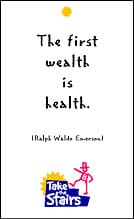 |
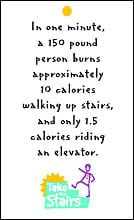 |
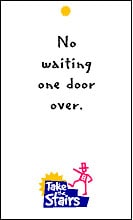 |
|
| Remember to first test them with your audience! | |||
Set 1
|
Set 2
|
||
Taking the stairs is a great way to increase your daily physical activity. But let’s face it—if you must decide between riding to the 5th floor in a carpeted, well-lit elevator (which requires no effort) versus walking up flights of stairs surrounded by stark gray walls and concrete floors, which would you choose? An important motivator in encouraging people to take the stairs is making stairwells a safer, more inviting place to be.
What We Did
Through CDC’s “StairWELL to Better Health” project, the Rhodes Building stairwells were rejuvenated. First, carpeting was laid over the concrete stairs and flooring, and rubber treading was added to each of the steps to maximize safety.
Next, the bare walls were transformed by adding brightly colored paint, with each floor a different color. Framed artwork also was added to each floor, which featured people being active, photos of nutritious foods, and picturesque scenery. Royalty-free clip-art was used for many of the pictures, to keep the cost of artwork low.
| Before | |||
|---|---|---|---|
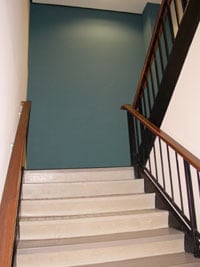 |
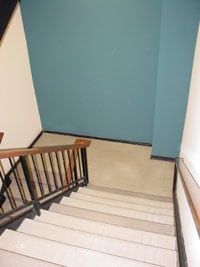 |
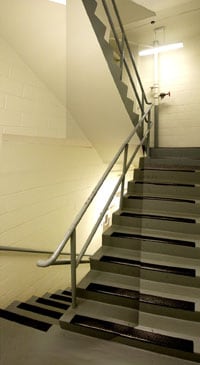 |
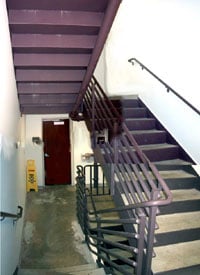 |
| After | |||
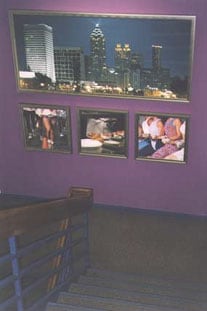 |
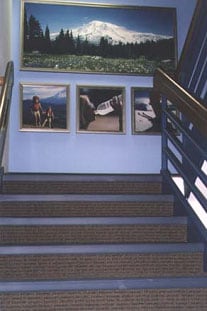 |
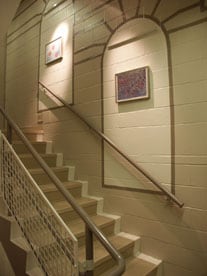 |
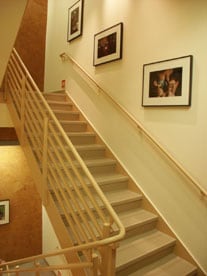 |
What You Can Do
A word about permits: check with your building manager and safety officer to identify all relevant permits, fire and building codes BEFORE you make your purchases. It would be a shame to spend a lot of money on framed artwork, for example, only to find out that it is against code in your area to hang them!
- Carpet your stairwell if it isn’t already, or if the carpet is in bad repair.
- Add rubber treading for safety.
- Paint the walls bright colors.
- Hang artwork in the stairwell, if permitted. Other ideas for framed art include cartoons and children’s art. Pictures should be changed periodically to keep stair users from getting bored.
- Create a project check list for materials and budget worksheets
- Be sure to leave room for motivational signs. The next page gives you examples of fun and functional motivational signs.
References
U.S. Department of Health and Human Services. Physical activity and health: a report of the Surgeon General. Atlanta: U.S. Department of Health and Human Services, Centers for Disease Control and Prevention, National Center for Chronic Disease Prevention and Health Promotion, 1996.
Looking for more ways to improve your stairwells? If your budget allows, you may want to work with an interior designer or color consultant to help you create the right “feel” for your stairwells. If not, consider the following ideas.
Physical Alterations to the Stairwell
- Adding carpet and rubber treading will increase safety and make your stairwell more inviting.
- Use creative lighting (e.g., track lighting, incandescent lighting, or halogen lighting).
- Create theme stairwells (e.g., transport stair users to a Hawaiian beach or tropical rainforest during their trip up or down the stairs, or make your own cartoon and have a frame or two per floor).
- Create a catchy rhyme with several lines. Put the first line of the rhyme on the first floor, the second line on the second floor, etc. One would have to travel all the way to the top to read the entire rhyme!
- Include an electronic message board.
- Add footsteps that lead from the elevators to the stairs and have a message spelled out along the way.
- Post arrows showing the way to the stairs.
- Create a “fitness zone” inside the stairwell: “You are entering the Fitness Zone.”
- Put numbers on the doors to let users know which floor they’re on.
- Start at bottom floor and give each stair a number so that users can easily track their progress.
- Allow users to add their signatures to each floor creating a graffiti wall.
Incentives
Incentives can be a great way to encourage people to use the stairs. Use your focus groups, or what ever method you are using to gather information about the signs, colors, and artwork to find out what kinds of incentives, within policy regulations, employees in your office would appreciate.
- Make it seem as if users are climbing some fixed point such as Mount Everest or a local landmark. On each flight, show them a “map” of where they are.
- Hold drawings among stairwell users for prizes, if such incentives are permitted. A kick-off event could be held with a “grand re-opening” of your stairwell. Another idea to consider is holding a contest where employees keep track of the number of flights they walk in a week or a month. Award prizes for 1st, 2nd and 3rd place! If prizes aren’t an option, have a contest where the winner may select the music or art in the stairwells for the next week or month.
- Have a general contest for slogans to increase stair use. These slogans can be incorporated into your artwork and motivational signs. Be sure to note who’s slogan is on which sign!
What You Can Do
Checklist
Increase AWARENESS: Make people aware of the stair options. For example, hang signs by the elevators saying, “Have you thought of taking the stairs today?” Remind people of the health benefits associated with physical activity, and appeal to the environmentally conscious by pointing out how much energy is used in running an elevator.
Enhance SKILLS: Build employee self-confidence. Help those who are willing to take the stairs, but who tire easily or have other barriers to overcome to successfully use the stairs on a regular basis. Employees don’t have to be able to do 5 or 10 flights at a time. Provide motivation and support for taking the stairs even once a day, one flight a day, and build from there. This is where counting the stairs, marking how far one has gone on the stairs, and other such skill-building interventions are appropriate.
Provide OPPORTUNITIES FOR TRIAL BEHAVIOR: Offer opportunities for people to try using the stairs without ridicule or experiencing “failure.” Perhaps sponsor a “use the stairs for a day” campaign or make it fun and give people incentives and rewards for using the stairs for one flight, one day, or for one week.
Create a SUPPORTIVE SOCIAL ENVIRONMENT: If your stairwells were particularly unpleasant before your renovation, it may take some time to change people’s attitude about the stairwells. Talk about the stairwell in a positive manner, and make it seem like a fun place. Let the stairwell be a happy, fun place to be by providing employees with encouragement, incentives, and messages that support this perception.
Create a SUPPORTIVE PHYSICAL ENVIRONMENT: Clean, paint, and decorate the stairwell; add music and other physical intervention ideas to make the stairwell a pleasant place to be. Commit to maintaining the stairwell so it always looks its best!
